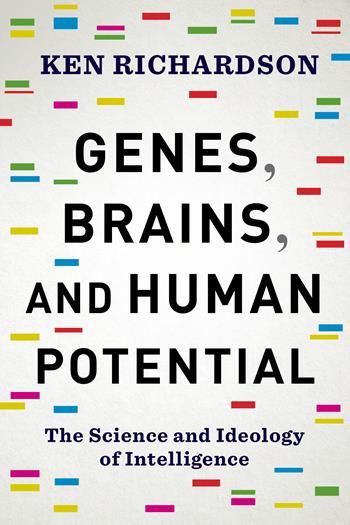Exciting Times in Brain Science
“Far from confirming what was expected, the research results, in fact, are suggesting something else: no less than a fundamental re-appraisal of many of our basic concepts. They indicate that expectations – the models framing research – have been more based on ideological assumptions that objective science. This is what happens when social experiences, such as class-structure or conventional gender roles, come to shape the concepts upon which scientific research is based – and which scientific research is then expected to reinforce.” — Ken Richardson
This week, our featured book is Genes, Brains, and Human Potential: The Science and Ideology of Intelligence, by Ken Richardson. Today, we are happy to present an article by Richardson on why the mountains of new data about particulars of brain activities have failed to construct a coherent model of overall function – what the brain is really for.
Don’t forget to enter our book giveaway for a chance to win a free copy of Genes, Brains, and Human Potential!
Exciting Times in Brain Science
By Ken Richardson
“These are exciting times in…” That’s a well-worn cliché, of course. But in two fields of science, at least, it’s not so trite. Advances in genetics over the last twenty years or so have been remarkable. Now DNA can be sequenced, and genes, even their molecular components – and who has them, or not – can be identified.
So the scene has been set for discovering genetic associations with complex diseases, or even individual differences in potential for traits like intelligence or education. And maybe that information can be used for selecting individuals for careers or as a basis for precision treatments in schools or families. In streams of exhortations, educators everywhere are now being told to think “genetically”.
Likewise with the brain: we’re enjoying a period of terrific breakthroughs, teeming with details about structure and function. New methods, particularly in “brain imaging”, have even produced speculation that the true nature of intelligence itself – and, again, who has it, or who does not – can be worked out “in the brain”. So teachers and educators are also being encouraged to be “brain scientists”.
But vaulting claims and promissory notes are one thing, reality another. High hopes about pinpointing genes are turning to disappointments. For well-defined medical conditions even weak genetic correlations have been difficult to establish. The difficulties are hugely magnified for traits like intelligence, for which there is not even agreed definition (quite apart from falling into the trap of automatically treating correlations as causes).
Far from confirming what was expected, the research results, in fact, are suggesting something else: no less than a fundamental re-appraisal of many of our basic concepts. They indicate that expectations – the models framing research – have been more based on ideological assumptions that objective science. This is what happens when social experiences, such as class-structure or conventional gender roles, come to shape the concepts upon which scientific research is based – and which scientific research is then expected to reinforce.
Probably top of the list of revision is the concept of the gene itself. Up to now it has been understood as a kind of autocratic “master molecule” with enormous powers. Together the genes have been assumed to dictate the programs that shape the brain and mind and, individual differences in them. But we now know that model to be quite wrong.
It is turning out that genes are more servants than masters, that the programs are created by the bodily systems themselves. Operating at numerous different levels, they react to environmental changes by utilizing the genes without being dominated by them. A kind of “intelligence” has even been found in the molecular ensembles of the single cell, “dancing to the tune of life” as Denis Noble puts it. Surprising, unexpected findings are bringing fresh new insights into the evolution of complex systems, from pre-life and early life forms to advanced cognitive systems.
Related revisions are coming out of the brain research. The area has hitherto been preoccupied with simple mechanical models. The search has been for the (mythical) engineering principles that will reveal the “machinery of the mind” (the title of many a book and paper). So we have continued to be wedded to a view of human brains as machines of different caliber designed by different quality genes, and to a “computational” view of thinking and learning.
That approach has revealed mountains of new data about particulars of brain activities. But it has failed to construct a coherent model of overall function – what the brain is really for. In consequence, important questions like how complex cognitive functions are related to signals between “dumb” nerve cells remain deeply puzzling.
The answers to these and many other questions are now being found in the dynamical principles displayed in natural systems everywhere: not in properties of elements, but arising from the myriad interactions among components. The components may be as small as molecules or nerve cell signals, as massive as people or populations. The dynamical properties of interactions create new emergent functions and novel responses to changing environments, just as the interactions between oxygen and hydrogen atoms create a molecule (water) with properties not inherent in either alone.
So the reappraisal is describing how collections of molecules can behave so “intelligently”, how interactions between cells, and between them and changing environments, guides development and variation in organisms, using genes but not dictated by them. It also shows how the same principles have been extended and amplified in the course of – and even directing – evolution.
The descriptions, in turn, have paved the way for better understanding of the evolution of ever more complex systems, in which potential is not already laid down in genes (the conventional view), but is “made” in the course of life-long development. In particular, the dynamical systems view describes how cognition emerges from nerve networks in brains, regulates learning and behaviour, and has laid the foundations of sociality in organisms. Above all, that view presents a more plausible explanation of the incredible creativity of human socio-cognition, and, indeed, what it means to be human.
Would it be nice to have all that comprehensively disclosed in a handy, readable, text? Genes, Brains and Human Potential: the Science and Ideology of Intelligence aims to do just that. It takes us from an understanding of the nature of ideology in science to illustrations of how it has perverted research and theory, and then from a description of the “intelligence” of the single cell to the evolution of intelligent systems across so many levels, to the human mind itself.
Finally, my book considers the applied consequences of the emerging view. It shows that the “problems” of society are not ones of a particular class or classes (the usual suspects); instead, they lie in the dynamics of the class structure itself. It shows that the problems of education are not “genetic”, or “inferior brains”; rather, they emanate from the crude models of learning and intelligence used in the schools and elsewhere. And it shows how these problems can be overcome – if we seriously want to!






